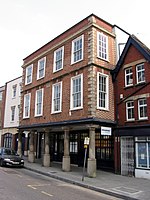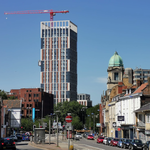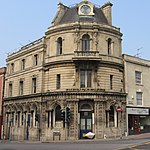Stag and Hounds, Bristol

The Stag and Hounds is a grade II listed pub in Old Market, Bristol. The oldest parts of the building date to 1483, when it was probably as a private house. The current building is predominantly from the early 18th century, when it became a pub. It was partly rebuilt in the 1960s, and refurbished in 1987. At one time the inn was flanked by houses, but the building of a dual carriageway underpass has left it isolated. A well in the former rear court has a 19th-century iron hand pump with flywheel and pump rods, an early example of an installation for raising water from a well. This old iron pump, operated by a wheel six feet in diameter, is in fine condition and all its parts still move. It is unique in Bristol.There is also a minute window looking out onto the courtyard, which opens onto a small room set between floors and is only accessible through a trap-door in what is now a bathroom. It is possible that this may be a survival from the days of priest-hunting. The modern day pub is renowned as a live music venue with a wide variety of bands ranging across many genres.
Excerpt from the Wikipedia article Stag and Hounds, Bristol (License: CC BY-SA 3.0, Authors, Images).Stag and Hounds, Bristol
Temple Way, Bristol Broadmead
Geographical coordinates (GPS) Address Nearby Places Show on map
Geographical coordinates (GPS)
| Latitude | Longitude |
|---|---|
| N 51.455451 ° | E -2.583203 ° |
Address
Temple Way
Temple Way
BS2 0FX Bristol, Broadmead
England, United Kingdom
Open on Google Maps









